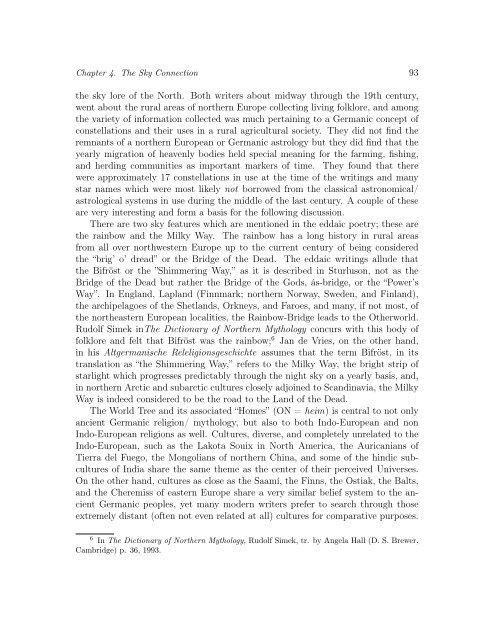Untitled - Awaken Video
Untitled - Awaken Video
Untitled - Awaken Video
Create successful ePaper yourself
Turn your PDF publications into a flip-book with our unique Google optimized e-Paper software.
Chapter 4. The Sky Connection 93<br />
the sky lore of the North. Both writers about midway through the 19th century,<br />
went about the rural areas of northern Europe collecting living folklore, and among<br />
the variety of information collected was much pertaining to a Germanic concept of<br />
constellations and their uses in a rural agricultural society. They did not find the<br />
remnants of a northern European or Germanic astrology but they did find that the<br />
yearly migration of heavenly bodies held special meaning for the farming, fishing,<br />
and herding communities as important markers of time. They found that there<br />
were approximately 17 constellations in use at the time of the writings and many<br />
star names which were most likely not borrowed from the classical astronomical/<br />
astrological systems in use during the middle of the last century. A couple of these<br />
are very interesting and form a basis for the following discussion.<br />
There are two sky features which are mentioned in the eddaic poetry; these are<br />
the rainbow and the Milky Way. The rainbow has a long history in rural areas<br />
from all over northwestern Europe up to the current century of being considered<br />
the “brig’ o’ dread” or the Bridge of the Dead. The eddaic writings allude that<br />
the Bifröst or the ”Shimmering Way,” as it is described in Sturluson, not as the<br />
Bridge of the Dead but rather the Bridge of the Gods, ás-bridge, or the “Power’s<br />
Way”. In England, Lapland (Finnmark; northern Norway, Sweden, and Finland),<br />
the archipelagoes of the Shetlands, Orkneys, and Faroes, and many, if not most, of<br />
the northeastern European localities, the Rainbow-Bridge leads to the Otherworld.<br />
Rudolf Simek inThe Dictionary of Northern Mythology concurs with this body of<br />
folklore and felt that Bifröst was the rainbow; 6 Jan de Vries, on the other hand,<br />
in his Altgermanische Releligionsgeschichte assumes that the term Bifröst, in its<br />
translation as “the Shimmering Way,” refers to the Milky Way, the bright strip of<br />
starlight which progresses predictably through the night sky on a yearly basis, and,<br />
in northern Arctic and subarctic cultures closely adjoined to Scandinavia, the Milky<br />
Way is indeed considered to be the road to the Land of the Dead.<br />
The World Tree and its associated “Homes” (ON = heim) is central to not only<br />
ancient Germanic religion/ mythology, but also to both Indo-European and non<br />
Indo-European religions as well. Cultures, diverse, and completely unrelated to the<br />
Indo-European, such as the Lakota Souix in North America, the Auricanians of<br />
Tierra del Fuego, the Mongolians of northern China, and some of the hindic subcultures<br />
of India share the same theme as the center of their perceived Universes.<br />
On the other hand, cultures as close as the Saamí, the Finns, the Ostiak, the Balts,<br />
and the Cheremiss of eastern Europe share a very similar belief system to the ancient<br />
Germanic peoples, yet many modern writers prefer to search through those<br />
extremely distant (often not even related at all) cultures for comparative purposes.<br />
6 In The Dictionary of Northern Mythology, Rudolf Simek, tr. by Angela Hall (D. S. Brewer,<br />
Cambridge) p. 36, 1993.
















